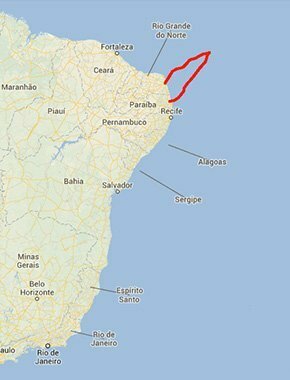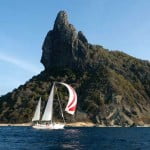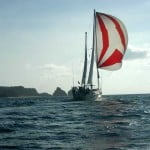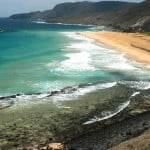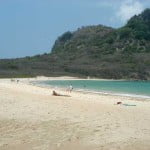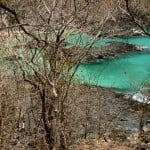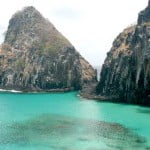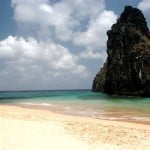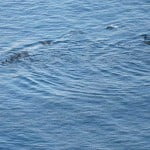Friday – 23 – 09 – 2005
We arrived at the island last night by plane after having stopped in Recife.
The Endless Sea had been waiting for us since Wednesday the 21st. Our sailboat came from Natal piloted by Alonso, who was helped by Dede (the same person who helped Alonso to sail from Fortaleza to Natal). Since we have had very little time between one trip and another, I asked Alonso to bring the boat while we were editing the last programs in São Paulo. As soon as this job was done, we caught a plane and came here to meet him. As usual, reporter Paulina Chamorro and film maker Cardozo were with me. We intend to make two other programs in Noronha. Then Paulina will go back to São Paulo with the tapes in order to have them edited, while Cardozo, Alonso, Dede and I will hold the regatta Fernando de Noronha – Cabedelo so that we can have a third program recorded on our way back to the coast, this time the coast of Paraiba.
Yesterday we navigated around Fernando de Noronha to take pictures from all possible angles. It took us three hours to cover the 18 miles around the island using the motor. Apparently there aren”t big changes that can be noticed from the boat. I first came here in 1986 when the second regatta Recife – Fernando de Noronha was held by six boats, four of them Brazilian and two South African, including Kalahari, in which I was. I have been to Fernando de Noronha many times since then and the only visible change is the break-water which protects a small pier that was built. The rest remains untouched. After having navigated around the island we shot with all the sails opened. At first we used the genoa (a prow sail used with the foul wind) then the balloon (also a prow sail but it is used when the wind comes from behind) and these two things took us almost all the day.
The island is agitated. It is always like this during this time of the year, because of the arrival of the Recife – Noronha regatta fleet that starts on Saturday the 24th and the first ones will be back on Monday early in the morning. More than a hundred boats are expected with approximately 500 / 700 crew members, plus tourists coming by plane. All of them will be requiring services, therefore, economically speaking it is an important event. Especially due to the fact that everybody here makes their living from tourism. There aren”t many job options in Noronha. In addition to tourism, there are jobs linked to the administration of the archipelago and the bases of Tamar and the Rotator Dolphin Project, nothing else.
Tomorrow we have some submarine shootings scheduled. There are many Endless Sea TV viewers who want that.
Saturday, 24 – 09 – 2005.
We left early in the morning for the first dives. We went to Ponta da Sapata that is at Noronha”s west end, at a depth of approximately 25 meters. Fortunately, the sea was calm and there were weak winds enabling us to dive in crystalline water and to enter in caves, something that is always imagined by people when they think of submarine dives. After this first dive, the crew had a second one in the morning (I decided to skip that because my ears were painful). It”s not wise to insist when decompression is not perfectly succeeded. I”ve got the flu recently and that”s probably why I”m not completely recovered. Since diving is a sport that requires a lot, it is better not to exaggerate. I preferred to stay here, reading and preparing myself for tomorrow”s shootings, while Paulina and Cardozo dove twice after lunch.
The regatta Recife – Fernando de Noronha started today at 2 p.m. The winner will probably arrive here tomorrow at the end of the day.
After the afternoon dives, Paulina and Cardozo came back on board. We had diner in the boat and went to bed. They were exhausted.
Sunday, 25 – 09 – 2005.
We shot Remedios” Village and some historical buildings. We want to show on these programs that Fernando de Noronha is not only a “tropical paradise”, but a place where almost three thousand people live, a district of Pernambuco, like the others, although it is in an exotic and charming place: the Atlantic Ocean, at 032° 24” 00″ of West longitude and 03° 50” 00″ of South latitude. It was first called Ilha da Quaresma ( Lent Island), then São Lourenço, at last it was called after his owner, a new Christian, who leased all the land we call Brazil. Yes, few people know that our country was once a huge portion of land leased by a consortium headed by the shipowner, businessman and investor who was immortalized when his name was given to one of the world”s most beautiful archipelagos, also known as the Atlantic Emerald, since during the rain season the vegetal cover becomes green. We are talking about Fernando de Noronha which was officially discovered in 1503 on Gonçalo Coelho and Américo Vespúcio”s second trip to Brazil. It was at Espigões, a type of reef at the east end of the island where the first shipwreck occurred on August 10th, São Lourenço”s day, that”s why this was the second name given to the island. That”s where Gonçalo Coelho”s ship sank, although this accident didn”t cause any deaths. The crew was saved and transferred to one of the five ships of the fleet. Vespucio the man who, by a fortuitous chance of history, ended by giving his name to the continent discovered by Columbus, was here for a week. In his letter, he says: “The island was totally uninhabited and unoccupied, there was plenty of fresh water and uncountable trees and marine and terrestrial birds that were so docile that it was possible to catch them by hand, and we caught so many that one of the boats was full of them.” It was always the same. As soon as a piece of land was discovered, the Portuguese got off to pick up water, firewood and food. Deforestation in Brazil started right after it was discovered, that”s why the resisting capacity of the forest is remarkable. And during the great navigation period it was like this. As soon as a new boat or fleet arrived, the first thing they did was to get off to cut the trees down in order to have fire and catch birds to eat. On the following trips, they used to leave a significant number of goats. Yes, this animal that eats everything: roots, trees, seeds, stones, sand, anything. It was left as food especially because it resists and proliferates anywhere and it could be an alternative for birds. Not a very long time ago, it was possible to find these animals in Abrolhos, Noronha and Trindade. I saw them many times during my first sailing trips on the Brazilian coast and that made me mad. In Trindade, the most distant island on Espirito Santo”s coast, some of them can be found. The elite shooter from the Brazilian Navy wasn”t able to hit them. It was a long time until this measure was finally taken in the 80s: to exterminate these predators. Their presence for such a long period, the firewood cut, Pau Brasil””s exploitation since the beginning of the 16th century and the human occupation starting in the 17 and 18th centuries resulted in extremely arid islands. Abrolhos, in the south of Bahia, has not a single tree. Trindade, in whose woods Robert Scott”s sailors got lost in 1922”s conquest race, is almost naked, there is just a wood with giant endemic ferns at the top of the highest hill. And here in Noronha, it is the same. Just in a few small places there is some of the old and exuberant vegetal cover that dubbed the island the Atlantic Emerald. The coup de grâce came with the decision of turning Noronha into a political prison. The head of the island-prison didn”t want either woods where the prisoners could hide themselves or trees that could become rafts, burning in the prisoners” minds. That”s why he decided to have all the remaining trees cut down. It was a pity. Until the 19th century, travelers could be charmed by native forests. Charles Darwin, who was here in 1831, described Noronha as an island “covered by forests”. But if you come here today, you don”t see them any more. There is just one kind of grass – jeritana – a plague that has almost covered the whole island. When it rains, everything inevitably collapses, the land falls and may cover the coral reefs at the bottom of the hills at the edge of the sea asphyxiating them…
Islands and archipelagos are like that: extremely fragile places that are not strong enough to regenerate by themselves. After many years of bad treatment and unworried harmful occupation, they ask for our help to maintain part of the original characteristics. This at least seems to be done here. Part of Praia dos Golfinhos” wood is being recovered. Cuttings of mulungus, gameleiras and ipês (different kinds of trees) have been planted.
Well, today we have walked around the village and noticed the prices of goods sold here. Everything here is brought by boat and the transportation price is charged. Noronha is one of the most expensive cities in Brazil. Anything you buy at the supermarket is two or three times more expensive compared to the other states of the continent, especially perishable goods.
We also visited Remedios Fortress” ruins, an imposing building from the 18th century from which the sea can be widely seen and it results from the Portuguese effort of protecting the land that had already been in French and Dutch hands and claimed by the English. It was quite sad to see how abandoned it was. In spite of making every tourist pay 30 reais when the fortress is visited – there are about 500 visitors every day – apparently this sum has not been used to preserve this National Patrimony. In addition to the fortress, we saw the ruins of the women”s old prison, where Miguel Arraes was kept as a prisoner in 1964 and it is very badly preserved. If nothing is done, it will collapse soon. Fortunately, the church of the village from colonial times was in good shape. Tomorrow, we will talk to the island administrator, here there is no governor. Maybe he will tell us where the money is spent and which Fernando de Noronha”s greatest virtues and problems are.
Monday, 26 – 09 – 2005.
Today we woke up early, before dawn, and went to Praia dos Golfinhos to follow the Rotator Dolphins Project”s watch here in Fernando de Noronha. Most of the day is devoted to watching these dolphins coming and going, there are groups from 5 to 1200 dolphins which use this creek to rest, eat and copulate. Thus, these groups can be monitored, counted in each group, and anomalies can be detected. It seems that this work is well done by Ibama and it is also important, that”s why we made an appointment with Fabiana Cava, project coordinator. It was worthwhile seeing both the view and the native forest we had to cross to reach the edge of the abyss from which the bay is seen. I could feel a little bit of the original forest described by all those who had been here during the first centuries after the discovery. Imposing trees such as the mulungo, ipê, gameleira and many bushes and underbrushes. Unfortunately, during this period of this year, the dry season, the forest is a bit colorless, faded. It is just the opposite if compared with winter time, when it rains and the forest is dyed in exuberant green. Anyway, we could see the efforts made by Ibama”s people to reforest the open areas where there were bushes before. Like in all the islands, Noronha”s environment has suffered a lot since it was discovered from the human presence and the damages caused. An emblematic example is the rat. It was introduced with the boats that arrived here in the 60s. To exterminate them, a soldier from the detachment of the island suggested to the commander to bring lizards, the teju type, a good predator for rats. But rats have a day routine whereas lizards have a night routine. They never meet. This resulted in great proliferation of tejus that found excellent food in turtle eggs and since there are no natural predators for them they reproduce significantly. Today they are an environmental problem maybe greater than rats…
After the dolphins” watching program, we went back to the Endless Sea anchored in Santo Antonio bay where we waited for Tamar people”s visit who take care of turtles that lay eggs, especially at Lion”s beach, one of the most beautiful. At first, we had decided to go with them, fortunately they came on board and brought one of those huge turtles to mark it here on the boat deck. Tamar”s people, among other things, collect DNA samples from the turtles for research purposes and then make marks on their skin so that when they are caught again, thousands of miles away, they can be warned, consequently know their migration route.
Once again, we interviewed and shot Tamar”s responsible, Alice Grossman, and ended another working day. In the evening, we got off to walk around and go to Bar do Cachorro (Dog”s Bar), a famous bar where forro (a popular dance) is danced every evening, but we didn”t want to wait for the beginning of the party. We went back to the boat before 11 p.m. exhausted after another lengthy day, always exposed to the sun and very strong wind. Being all day in the open air makes us very tired. A lot of energy is required to feel like going out and dancing at night. It was not our case.
Tuesday, 27 – 09 – 2005.
Today, early in the morning, we had an appointment with Fernando de Noronha”s general administrator, Edrise Aires Fragoso. Since Noronha is Pernambuco”s district not municipality, the first agent mandatary. He is the governor”s trust man, he is chosen by him and is in charge of his duties for the same period of time. Edrise told us about the greatest problem in this community of three thousand Brazilians: lack of water. This year it hasn”t rained a lot, the island”s dam, Xareu, is empty. We went there and saw with our own eyes: no water at all. The salvation is a couple of generators having the capacity of producing 8 thousand liters of water per hour. Since there are two, the volume of water is 16 thousand liters/hour, which is enough to supply the population, if the shift is respected.
When you arrive in Noronha, you pay a fee of 30 reais for environmental preservation purposes. This fee plus service taxes collected made the district earn approximately 6 / 7 million reais last year. I asked M. Edrise if he intended with these funds to preserve the local patrimony, especially the fortress and other colonial buildings in bad state of preservation. No. This money is used to afford public services such as garbage collection. At least in this case we have a reference, specifically in Noronha, where 99% of the houses have garbage collection and 59% of the waste is treated. Thanks God! We have been insisting on this issue since Oiapoque”s district, and we are relieved to know that one of them, or almost, have reasonable rates of garbage collection and sanitation system.
Edrise told us that in Noronha there are approximately 2300 permanent inhabitants and 800 live there temporarily. They are professionals who come to render services and there are also tourists which depend on the local economy. Apart from the jobs of this activity, there are only 180 public employees on the island, the rest make their living from services and jobs opened by public visitation. The greatest limitation that blocks development is lack of water. According to the administrator, Noronha has been asked to receive more tourists and increase the number of inhabitants (10.000) in order to become a municipality, but the state government doesn”t accept more people, because infrastructure is below this capacity. Apart from the issue of lack of water, he said that there is a constant list of inhabitants who want to have houses in the island. The land belongs to the Union and is “lent” to people who use them, nevertheless, there is not enough room for everybody. That”s why there is a list of 180 names, people who are here but who for no specific reasons don”t have the house they want. As far as the Public Patrimony is concerned, Edrise says that he has a project at Prodetur and that he has also been working with PPPs to get funds to restore them. He added that tourism is constantly growing, especially international tourism. Here are the figures: in 2002 Noronha welcomed 5% of foreign tourists, in 2003, 15%! This year in August, 47% were foreigners. As we can see, they have been here and loved it.
From there we went to other beaches in order to make more films and also went to the place where the desalination system is. We went back to the Endless Sea. We were tired. We just got off the boat to have a shower at the port and eat pasta at the restaurant nearby. Then we returned to the boat. Paulina went to the cabin. Cardozo is snoring out and I”m about to finish my today”s logbook.
Wednesday, 28 – 09 – 2005.
Another day interviewing authorities, especially administrator Edrise, and the head of the National Park, Marco Aurélio da Silva. Fernando Noronha was turned into a National Marine Park in 1988, the total area is 112,7 square kilometers and 85% of it is marine area. There are less than 4 miles from the equator, in fact, at 3° 54” south, that is approximately 230 miles from the Equator, the imaginary line that divides the globe at zero degrees, the North hemisphere on one side and the South hemisphere on the other. That”s why the time zone is more than one hour as refers to Brasilia. Noronha is 345 kilometers away from Rio Grande do Norte”s coast. And it has been part of Pernambuco state since the 1988”s Constitution. Another curious aspect is that this island has the shortest federal road, Br 363, 7,5 kilometers long, connecting Santo Antonio Port with Remedios” village and the airport.
During the 18th century, the Portuguese built fortresses, and the only one that resisted is Nossa Senhora dos Remedios Fortress. Nevertheless, it is abandoned. During the second world war, Fernando de Noronha received a significant army contingent, and at that time Noronha became a Federal Territory and it was also an American base that monitored the South Atlantic. Today, it is possible to see cannons spread here and there as well as a few old barracks made of oval aluminum plaques typical from those films on the Pacific war (see pictures).
The archipelago is a stop point for migratory birds that fly the north-south route. It is also a habitat for many others, such as man-of-war birds, albatrosses, trinta-reis, or the endemic ones such as sebito and cucuruta.
But the richest aspect in terms of biodiversity are the waters. Different kinds of corals and fishes, marine turtles, sharks, dolphins and sometimes jubarte whales. All this near submarine volcanoes that exploded 12 million years ago and gave origin here to an archipelago of 21 islands. Around it, the bottom of the ocean is 4 thousand meters. The color of the water shows how deep it is, it is something between blue and a deep, limpid and crystalline purple. And all these colors together, that from the sea, either green or deep blue, beige and many other pastel shades from the beach, black from the rock crags, and green from the vegetation, all together, make Noronha look like a painter”s palette, it is so beautiful that it blurs the eyes. Everywhere you look at there is a natural beauty in its roughest strength. It is an animated piece of land struggling to survive among very powerful elements: the wind blows impudently, the sun and the heat beat until there is light, lack of water during a period of the year and too much water during the rest, and the sea all around ready to swallow whatever is possible. It is not easy to occupy an area like this without damaging it, but the results seem reasonable to me. Somehow, all the inhabitants work, tourism makes the economy dynamic and the inns don”t change the local “architecture”, on the contrary, they are part of it and are not harmful as regards the natural beauty of the coast because they were built away from it, in the country. Therefore, all the places we visited during our journey, such as the coast of Maranhão, Piaui, Ceara and Rio Grande do Norte, these two last states suffered an intense real estate speculation and were tremendously harassed by investors from the tourism field. There are two remarkable places – both could make their living out of tourism without affecting their natural site – the Parnaiba Delta and Fernando de Noronha. One needs to make occupation grow in order to achieve self sustainability (this concerns the Parnaiba Delta) and the other has to keep controlling the number of visitors strictly in order to refrain great amounts of tourists from destroying what they like most: the exuberant landscape of the island. Both are interesting and possible challenges and may be good examples for other parts of Brazilian coastal zones that haven”t been occupied so far. You just have to be careful to what happens in these places and feel like doing so.
Thursday, 29 – 09 – 2005.
Last night we went to the party of the Recife – Noronha regatta awards. Once again, the Adrenalina Pura catamaran got the blue ribbon. It took hours as usual and state governor Jarbas was present this year.
We fueled the Endless Sea for the regatta tomorrow and got supplies of water and ice. We visited the Brazil”s Navy school ship, Cisne Branco (White Swan), which always participates in the Recife – Noronha regatta. It is a copy of a clipper, x meters long, one thousand tones of displacement and 56 crew members. It is a beautiful boat where the Brazilian sailors” skills are improved. It was built in the Netherlands and the Navy incorporated it in 2000 as part of the celebrations of the 500 years of the discovery and since then it has been used as a school ship and has represented our country abroad. It is a three mast ship: the fore mast, the main mast, x meters high, and the mizzen mast. All of them with many transversal yards through which the round sails of the ship are open. At the bow, there is a huge bowsprit where three or four triangle sails are seen. We were welcomed by captain Vinicius, who was extremely nice, showed us the boat and explained every single detail. After the visit, he gave us a nice interview insisting on the need of offering to professional sailors today, who will be dealing with very modern machines, training on sailboats skills, like those who sailed in the 19th century. To him, nothing better than the sail has been invented so far, the tradition, the knack and the rules to train a good sailor.
Friday, 30 – 09 – 2005.
Today, the departure of the Noronha – Cabedelo regatta was at 12:20. About 50 sailboats are participating (including the Endless Sea) out of the one hundred that came for the Recife – Noronha regatta. All types of boats: small and big boats, single hull boats and catamarans, modern and old boats, well, everything you like, even two beautiful French sailboats and a Spanish one, between 50 and 60 feet long, very modern, traditional, really beautiful. Three hours after the departure, the mast of one of the boats broke and it returned to Fernando de Noronha using the motor. It was a pity to see the skipper and the crew, this is the type of serious accident nobody wants. The wind was blowing continuously at approximately 22 knots, with blasts up to 26, 27 and during the first hours the sea was rough, with three-meter waves. This shock of forces and worn-out material made the competitor”s mast fall. It is wise to check the attachment of the steel cables that support the mast…
Our performance was neither good nor bad, we were sailing rather on the inner side of the wind line, hauling up the wind. After sailing for half a day, we left about 20 boats behind. In the evening the wind was stronger blowing at 26, 27 knots, with blasts at 30 knots. Most of the fleet “went down”, opened up the prow angle as refers to the wind, unlike us, we diminished as much as possible the angle of the Endless Sea, in nautical terms, we hauled up. Today, October 1st, that resulted in leaving 30 boats behind us. However, during the day, we haven”t seen anybody, the fleet dispersed. Anyway, the regatta is just an excuse to return to the continent and continue our goal which is above all to map how people have occupied the Brazilian coast. We will start our task again during our next trip in the seventh Brazilian coastal state from the north, Paraiba.
We have had a good performance during this regatta, we sailed for 24 hours and covered 160 miles, which is quite good for this type of boat. Now, it is 10:20 p.m., our log (the device that registers sailed miles) shows 220 miles. There are just 10 miles left to cross the line and cover the 230 miles of the regatta. Arriving at an unknown harbor is always difficult. It is a crucial moment. That”s why I”ll stop now. I will follow our arrival at the harbor.
Saturday, 02 – 10 – 2005.
We crossed the regatta”s arrival line at 0:20 a.m. We were already at Cabedelo port, in the Paraiba river, in the foul wind, which is unusual for a regatta. Participating was a great pleasure, a fun way to return to the continent. During this part of our journey, there were two friends with us, Plinio Romeiro Jr., a person who has great nautical sensibility and knowledge in general and Dede Delfino, a jack of all trades on board, from Ceara, who has helped Alonso since the Fortaleza – Natal journey. With five people on board, two of them experts, Alonso and Plinio, sailing is easy. It was an excellent trip and we had a lot of fun.
But now we have to return to our usual routine: São Paulo to edit the material then a new trip. We will visit the coast of Paraiba, our next stage


